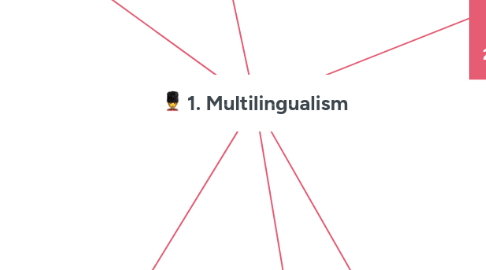
1. 4. Psycholinguistic aspects of TLL
1.1. Research on individual multilingualism studies: acquisition, use and processing.
1.2. 4.1 Effects of bilingualism on additional language learning
1.2.1. Studies indicate positive effect of bilingualism in TLA
1.2.2. Multilingual learning strategies
1.2.2.1. Different in mono or bilingual person
1.2.2.2. Strategies
1.2.2.2.1. Active learning approach
1.2.2.2.2. Realization of language system
1.2.2.2.3. Handling of affective demands
1.2.2.2.4. Monitoring of progress
1.3. 4.2 Crosslinguistic influence
1.3.1. Are influenced by:
1.3.1.1. The perceived distance between languages
1.3.1.2. The ability to use L2
1.3.1.3. Sociolinguistic and psycolinguistic aspects
2. 5. Educational aspects of TLL
2.1. 5.1 The complexity of multilingual education
2.1.1. Use + 1 language as media of instruction
2.1.2. Aim to proficiency in more than 2 languages
2.2. 5.2 Multilingual schooling: some examples
2.2.1. European minority language contexts. Ladin Valleys and Basque countrie.
2.2.1.1. Basque is not indoeuropean language. Big difference. Some subjects in English
2.2.1.2. Ladin Valleys. Mix languages from elementary school
2.2.2. European schools
2.2.2.1. Basic instruction in the official language of EU
2.2.2.2. L2 compulsory from Primary
2.2.2.3. L3 and L4 in secondary school
2.2.2.4. One subject is taught in L2
2.2.3. International schools. Vienna example
2.2.3.1. English exclusively for instruction
2.2.3.2. German as a first foreign language
2.2.3.3. Education in mother tongue is encouraged out of regular classes
2.3. 5.3 Multilingual teaching projects in EU
2.3.1. EuroCom (European Comprehension Project)
2.3.1.1. Understanding among people with own language family
2.3.1.2. Concentrate in receptive skills. Deduction
2.3.2. Projects founded by European Center of Modern Languages
2.3.2.1. Encourage excellence and innovation in language learning
3. 6. Emerging trends by the European Centre of Modern Languages
3.1. Language awareness
3.1.1. Learning to learn a language
3.1.2. Cross-language comparisons
3.2. 6.1 Focus on the multilingual learner
3.2.1. Is good transfer from one to other language
3.2.2. Languages are not closed
3.2.2.1. Permeable knowledge
3.3. 6.2 Focus on the multilingual teacher
3.3.1. Teacher with language learning experience
3.3.2. Help students with linguistic background
3.4. 6.3 Focus on multilingual didactics
3.4.1. The special role of English
3.4.1.1. Is the world language
3.4.1.2. Can limit multilingualism or
3.4.1.3. Can be used to stimulate other languages
3.4.2. Common curriculum and multilingual didactics
3.4.2.1. Trend to common curriculum for all languages with multilingual didactics
3.4.2.2. Promotes language learning and contact with other cultures
3.4.2.3. Latin can develop multilingualism
3.4.2.4. Investment in material development and teacher stimulation
4. 7. Challenges for the future
4.1. Languages taught need to be linked
4.2. Portfolios to show the positive effect of multilingualism
4.3. Language teachers must tend to be experts on multilingualism
5. 2. Researching Multilingualism
5.1. 2.1 History
5.1.1. - First studies. W. Brown. Negative influence on intelligence and congnition
5.1.2. - 60-70 Vildomec. L1 negative influence transfer
5.1.3. - 90's Stedjes and others. Bilingulism is positive to learn L3
5.2. 2.2 Definitions
5.2.1. Multilingualism learning of more 2 than languages
5.2.2. Conceptual framework.
5.2.2.1. Complexity TLA
5.2.2.1.1. Simultaneous L1/L2/L3
5.2.2.1.2. Consecutive L1/L2/L3
5.2.2.1.3. Simultaneous L2/L3 after L1
5.2.2.1.4. Simultaneous L1/L2 before L3
5.2.3. Learners and users
5.2.3.1. Multilingualism definitions
5.2.3.1.1. By origin -> Developmental phenomenon
5.2.3.1.2. By competence -> Competence in 2 or more languages
5.2.3.1.3. Functional -> functions of language in community
5.2.4. 2.3 Current models of TLA
5.2.4.1. Bilingual and multilingual productions models. (De Bot, Clyne)
5.2.4.1.1. Language choice is influenced by social and motivational factors
5.2.4.2. Activation/inhibition model. (Green)
5.2.4.2.1. Languages have different level of activation
5.2.4.2.2. Various degrees: selected to speak, dormant, etc.
5.2.4.3. The language mode hypotesis. (Grossjean)
5.2.4.3.1. Speaker chose the level of the language in conversation
5.2.4.3.2. Is the state of activation of the bilinguals at certain point in time
5.2.4.4. The factor model. (Hufeisen)
5.2.4.4.1. Factors which model language learning process: affective, cognitive, external, etc.
5.2.4.4.2. SLA and TLA is different. Knowledge of learning process.
5.2.4.5. The multilingual processing model (Meisner)
5.2.4.5.1. With languages related, p.e Romanic lang.
5.2.4.5.2. Learners uses a bridge language to consolidate new language.
5.2.4.6. A dinamic system theory of multilingualism (Herdina and Jessner)
5.2.4.6.1. Languages are open systems
5.2.4.6.2. Development of multiligual system changes depends on social, psycolinguistic and individual factors
5.2.4.7. The model of multilinguality (Aorin and Ó Laoire)
5.2.4.7.1. Multilingual communicator in determinate environment (social and phycological)
5.2.4.7.2. Language as one of the most defining attributes of a person.
6. 3. Sociolinguistic aspects of TLL
6.1. Multilingualism is the rule, not the exception in EU
6.2. 3.1 Multilingualism in European countries
6.2.1. A lot of examples: Switerland, Catalan countries, Austria, etc.
6.2.2. Usually English is L3 in all this zones
6.3. 3.2 Language prestige and attitudes towards plurilingualism
6.3.1. Language prestige influence language choice
6.3.1.1. Maintenance of certain language
6.3.1.2. Attitudes to learn new language

